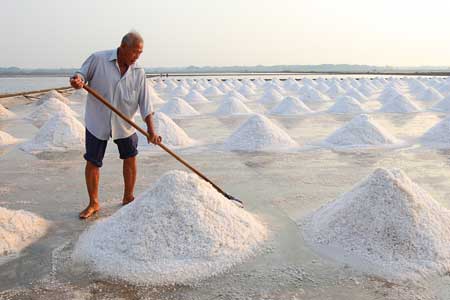当前位置: Language Tips> 双语新闻
Is sea salt healthier than table salt?

|
If you've been inside a grocery store in the past couple of years, you've probably noticed the trend in food manufacturers adding "Made with sea salt" to their product packaging. The claim shows up on a wide variety of foods - from organic whole grain pretzels, to mixed nuts, to "American deli cheese product." Clearly the food industry has decided salt from the sea is a major selling point. But why? Is it better for us than plain old table salt? "Sea salt gets a health halo, and people are using a lot more of it," said Alissa Rumsey, a registered dietitian at NY-Presbyterian/Weill Cornell Medical Center. "The most significant difference is the texture." Sea salts are coarser and grainier than table salt because the former undergo less processing than the latter, Rumsey said. Sea salts are made from evaporated sea water. Table salt, on the other hand, usually comes from underground salt mines and is processed into finer crystals. (Fun fact: If you're a sea salt fanatic and are confident your local seawaters aren’t polluted, you can make your own.) The less-processed aspect of sea salt may be appealing, but both types of salt have the same basic nutritional value, Rumsey said. “With some foods, less processing does equal healthier,” like whole grains versus refined grains, she said. “But I wouldn’t say sea salt is healthier than table salt. “A teaspoon of table salt is finer, so it has more sodium by volume. But technically by weight they contain the same percentage of sodium — about 40 percent." Table salt is usually fortified with iodine, a practice that's been around since the early 20th century. Sea salt may retain some other minerals depending on the water source - but generally not enough to make a difference in your diet. "Sea salt does have a small amount of trace minerals, but it's really too small to offer much benefit," Rumsey said. "We get those minerals in other forms from our food." One thing sea salt doesn't have is added iodine, which you'll often see noted on its label. Table salt has been fortified with iodine since the early 20th century as a way to get more of the essential mineral into Americans' diets. These days, Rumsey said, most Americans get plenty of iodine in their diets — so you shouldn't worry about using sea salt instead if you like its texture and crunch. The most important thing to remember: Sea salt is still salt, and you shouldn't consume too much of it. "I tell people that whatever salt you do decide to use, to do so sparingly," Rumsey said — and that goes for the sodium content in packaged foods, too. Aim for less than 2300 mg, or less than 1500 mg if you are over age 51 or have health concerns such as high blood pressure, diabetes or kidney disease. |
在过去几年里,你也许会在杂货店中发现这样一种趋势,越来越多食品加工商在产品包装袋印上了“添加海盐”的标识。从有机全麦椒盐卷到什锦坚果,再到美国熟食奶酪产品。 显然食品行业认为海盐是主要的卖点。可这是为什么?它真的比平常的食盐好吗? 纽约-长老会医院和威尔康奈尔医疗中心的注册营养师艾丽萨·拉姆齐说:“海盐戴上了健康的光环,比起以前人们更多地使用海盐。它们最主要的差别在于质地。” 拉姆齐说,比起食盐海盐更粗大有更多颗粒,因为它没有经过那么多加工。海盐是蒸发海水提炼出的。食盐则一般从地下盐矿开采出来,在加工成更细小的晶体。(有趣的是,如果你是海盐“粉”,同时又确信周围的海水未被污染,你可以自己生产海盐。) 因为经历更少加工,海盐可能更有吸引力,但两种盐都有同样的基本营养价值。拉姆齐补充道。 “对于某些食物,加工程序少确实更健康。”比如全谷物和精制谷物相比。“但我不认为海盐比食盐健康。”她说。 “一茶匙食盐颗粒更小,所以比一茶匙海盐含更多钠。但严格来讲,重量等同时,二者含有的钠所占百分比相同,大约百分之四十。” 从20世纪早期开始,食盐中一般都添加碘。 海盐根据海水来源的不同也会含有不同的矿物,但通常量很少不会对饮食造成影响。 拉姆齐说:“海盐中确实有少量的微量矿物质,但太少了不会给人体带来明显的益处。我们从其他形式的食物中获取这些矿物质。” 海盐没有添加碘,它的标签上也会标明。20世纪初,美国开始在食盐中添加碘好让人们能更多地获取这种人体必需的矿物质。拉姆齐表示,如今大多数美国人的饮食中已经补充了足够的碘,所以用如果喜欢海盐的质感和口感,用海盐来代替食盐的话也不用担心。 最重要的是要记住,海盐也是盐,不能吃太多。 “我会告诉人们,不管食用哪种盐都不要多。”拉姆齐说。对于包装食品的钠含量也是一样,要控制在2300毫克以内。如果年龄在51岁以上或有高血压,糖尿病或肾病等健康方面的担心,则要控制在1500毫克以内。 (译者 乔木子 编辑 齐磊) 扫一扫,关注微博微信
  |
上一篇 : 法国在强奸案发学校进行大规模DNA测试
下一篇 : 【我的中国梦】北斗村农民管乐队--草根乐队亮相国家级舞台
关注和订阅


电话:8610-84883645
传真:8610-84883500
Email: languagetips@chinadaily.com.cn